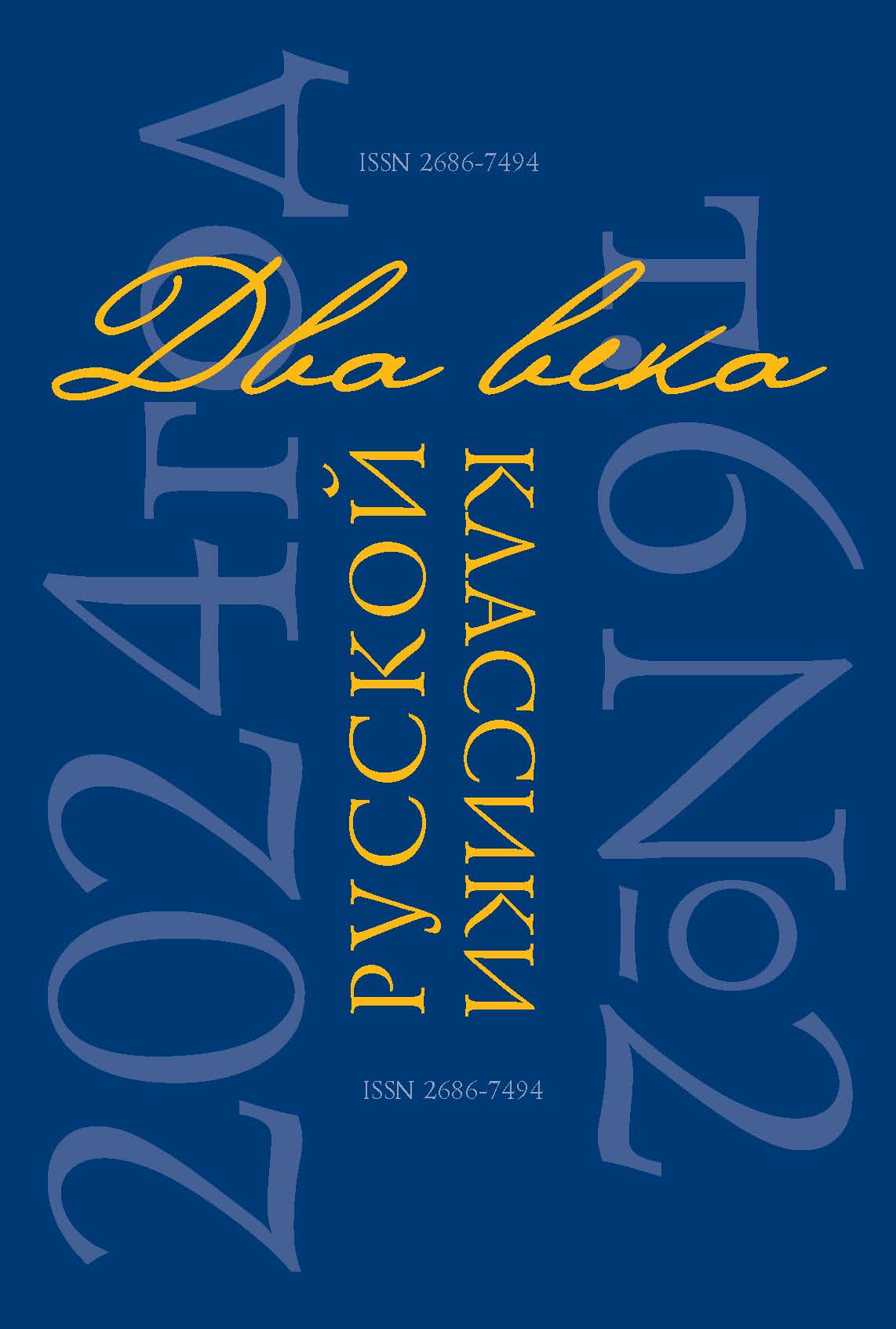Acknowledgments:
This work was carried out at IWL RAS with financial support of the Russian Science Foundation, project no. 22-18-00051 (https://rscf.ru/project/22-18-00051/).
Abstract:
The article is the first to reconstruct the estate theme in L. N. Tolstoy’s works in its intersection with the war theme. It turns out that the estate in Tolstoy’s works dedicated to war and revolutionary struggle plays a plotforming role. Using the examples of the stories “Caucasian Prisoner,” “Divine and Human,” the epic novel “War and Peace,” the author of the article traces the motif of the prodigal son’s return to his father’s house, his main phases of “departure” (“isolation”), “test” and “return” (“gaining new connections with the world”). War in this plot scheme appears as a limenal space of testing, the initiation of the soul on the path of returning to its true home. Summing up the results, it can be concluded that Tolstoy’s images of an ideal estate and house are opposed to war and are associated with biblical motifs of the Garden of Eden, a vineyard, symbolizing the “kingdom of God.” Tolstoy’s paradigm of the perception of the ideal estate as an image of righteous management and peacemaking, pacification of passions in serving God and people, becomes decisive in the depiction of the estate during the war in the literature of the 20th century.
References
Andreeva, I. S. “Filosofiia Shopengauera i russkaia literatura” [“Schopenhauer’s Philosophy and Russian Literature”]. Chelovek: Obraz i sushchnost’. Gumanitarnye aspekty, no. 1 (14), 2003, pp. 77–100. (In Russ.)
Andreeva, V. G. “Lev Tolstoi i Iasnaia Poliana v 1909–1910 gg. (memuaristika V. F. Bulgakova, N. N. Guseva, A. B. Gol’denveizera)” [“Leo Tolstoy and Yasnaya Polyana in 1909–1910 (Memoirs by Valentin Bulgakov, Nikolay Gusev, Alexander Goldenweiser)”]. Vestnik Kostromskogo gosudarstvennogo universiteta, vol. 28, no. 2, 2022, pp. 117–125. https://doi.org/10.34216/1998-0817-2022-28-2-117-125 (In Russ.)
Andreeva, V. G. “Usadebnyi mir v romane B. L. Pasternaka ʽDoktor Zhivago’.” [“Estate Life in Pasternak’s Novel ʽDoctor Zhivago’.”]. Filologicheskii klass, vol. 28, no. 1, 2023a, pp. 85–96. https://doi.org/10.51762/1FK-2023-28-01-08 (In Russ.)
Andreeva, V. G. “Usadebnyi topos u L. N. Tolstogo i B. L. Pasternaka: svoeobrazie i khudozhestvennaia preemstvennost’” [“Estate Topos of L. N. Tolstoy and B. L. Pasternak: Originality and Artistic Continuity”]. Karabikhskie nauchnye chteniia. Literatura — usad’ba — muzei: dialog kul’turnykh prostranstv (ot nekrasovskoi epokhi do nashego vremeni) [Karabikh Scientific Readings. Literature — Estate — Museum: Dialogue of Cultural Spaces (From the Nekrasov Era to Our Time)]. Yaroslavl, Akademiia 76 Publ., 2023b, pp. 5–12. (In Russ.)
Andreeva, V. G. “Usad’by v romane L. N. Tolstogo ʽVoskresenie’: ot oblicheniia roskoshi k zhizni na zemle” [“Estates in Leo Tolstoy’s Novel ʽResurrection’: From Denouncing Luxury to Life on Land”]. Filologicheskii klass, vol. 26, no. 2, 2021, pp. 144–154. https://doi.org/10.51762/1FK2021-26-02-12 (In Russ.)
Bogdanova, O. A. “Zhivye korni literaturnykh usadeb” [“Living Roots of Literary Estates”]. Usad’ba real’naia — usad’ba literaturnaia: vektory tvorcheskogo preobrazheniia [Real Estate — Literary Estate: Vectors of Creative Transformation]. Moscow, IWL RAS Publ., 2021, pp. 18–27. (In Russ.)
Bogdanova, O. A. Usad’ba i dacha v russkoi literature XIX–XXI vv.: topika, dinamika, mifologiia [Estate and Dacha in Russian Literature of the 19th–21st Centuries: Topoi, Dynamics, Mythology]. Moscow, IWL RAS Publ., 2019. 288 p. (In Russ.)
Bocharov, S. G. “ʽMir’ v ʽVoine i mire’.” [“ʽPeace’ in ʽWar and Peace’.”]. Bocharov, S. G. O khudozhestvennykh mirakh [About Artistic Worlds]. Moscow, Sovetskaia Rossiia Publ., 1985, pp. 229–248. (In Russ.)
Gacheva, A. G. “ʽPochemu mir ne mir?’ Obraz voiny v filosofii russkogo kosmizma” [“ʽWhy is the World not Peace?’ The Image of War in the Philosophy of Russian Cosmism”]. Solov’eevskie issledovaniia, issue 1 (49), 2016, pp. 44–62. (In Russ.)
Gulin, A. V. “Sobornost’ ili ʽroevoe chuvstvo’? (Russkii mir 1812 goda v ʽVoine i mire’ L. N. Tolstogo)” [“Collegialiity or a ʽSwarm Feeling’? (Russian World of 1812 in ʽWar and Peace’ of L. N. Tolstoy)”]. Vestnik Tverskogo gosudarstvennogo universiteta. Seriia “Filologiia”, no. 3, 2018, pp. 11–22. (In Russ.)
Dolzhenkov, P. N. “Tolstoi i Shopengauer: ʽAnna Karenina’.” [“Tolstoy and Schopenhauer: ʽAnna Karenina’.”]. Voprosy filosofii, no. 2, 2016, pp. 105–112. (In Russ.)
Evlampiev, I. I. “Vliianie filosofii A. Shopengauera na istoricheskie vozzreniia L. N. Tolstogo v romane ʽVoina i mir’.” [“The Influence of A. Schopenhauer’s Philosophy on the Historical Views of L. N. Tolstoy in the Novel ʽWar and Peace’.”]. Veche. Ezhegodnik russkoi filosofii i kul’tury, no. 31, 2019, pp. 15–36. (In Russ.)
Knorre, E. Iu. “ʽKitezh sovetskogo vremeni’: obraz ʽnebesnoi kommuny’ v ʽusadebnom mife’ M. M. Prishvina (na materiale dnevnika pisatelia 1920–1950 gg.)” [“ʽKitezh of the Soviet Era’: The Image of the ʽHeavenly Commune’ in the ʽEstate Myth’ of M. M. Prishvin (Based on the Writer’s Diary of 1920–1950)”]. Usad’ba real’naia — usad’ba literaturnaia: vektory tvorcheskogo preobrazheniia [Real Estate — Literary Estate: Vectors of Creative Transformation]. Moscow, IWL RAS, Melikhovo Publ., 2021, pp. 205–217. (In Russ.)
Knorre, E. Iu. Siuzhet “puti v Nevidimyi grad” v tvorchestve M. M. Prishvina 1900–1930-kh gg. [The Plot of the “Path to the Invisible City” in the Works of M. M. Prishvin in the 1900–1930s: PhD Dissertation]. Moscow, 2019. 295 p. (In Russ.)
Knorre, E. Iu. “Usad’ba i voina v ego-dokumentakh 1918–1922 gg. (dnevniki M. Prishvina i S. Durylina)” [“Estate and War in Ego-documents of 1918–1922. (Diaries of M. Prishvin and S. Durylin)”]. Novyi filologicheskii vestnik, no. 2 (65), 2023, pp. 109–122. https://doi.org/10.54770/20729316-2023-2-109 (In Russ.)
Koz’menko, M. V. “Artur Shopengauer v rannikh dnevnikakh i pozdneishikh proizvedeniiakh Leonida Andreeva: k probleme korreliatsii filosofskoi i khudozhestvennoi kartin mirozdaniia” [“Arthur Schopenhauer in the Early Diaries and Later Works of Leonid Andreev: On the Problem of Correlation of Philosophical and Artistic Pictures of the Universe”]. Izvestiia RAN. Seriia literatury i iazyka, vol. 69, no. 6, 2010, pp. 21–30. (In Russ.)
Monin, M. A. “Tolstoi i Fet. Dva prochteniia Shopengauera” [“Tolstoy and Fet. Two Interpretations of Schopenhauer”]. Voprosy filosofii, no. 3, 2001, pp. 111–126. (In Russ.)
Nagina, K. A. “ʽIdeia sada’ v tvorchestve L. Tolstogo: ot ʽKazakov’ v ʽVoskreseniiu’.” [“ʽThe Idea of a Garden’ in the Works of L. Tolstoy: From ʽCossacks’ to ʽResurrection’.”]. Vestnik Udmurtskogo universiteta, no. 4, 2011, pp. 8–17. (In Russ.)
Opul’skaia, L. D. “Roman-epopeia L. N. Tolstogo ʽVoina i mir’.” [“L. N. Tolstoy’s Epic Novel ʽWar and Peace’.”]. Moscow, Prosveshchenie Publ., 1987. 176 p. (In Russ.)
Orekhanov, Iu. L. “Pechvork-religiia L. N. Tolstogo” [“Patchwork Religion of Leo Tolstoy”]. Gumanitarnye issledovaniia v Vostochnoi Sibiri i na Dal’nem Vostoke, no. 4 (38), 2016, pp. 100–106. (In Russ.)
Podartsev, E. V. Mir russkoi usad’by v tvorchestve L. N. Tolstogo [The World of the Russian Estate in LeoTolstoy’s Works: PhD Dissertation]. Moscow, 2008. 171 p. (In Russ.)
Tiupa, V. I. Analiz khudozhestvennogo teksta [Analysis of Artistic Text]. Moscow, Akademiia ubl., 2009. 336 p. (In Russ.)
Khondzinskii, P., archpriest. Tserkov’ ne est’ akademiia: Russkoe vneakademicheskoe bogoslovie XIX veka [The Church is not an Academy: Russian Non-Academic Theology of the 19th Century]. Moscow, St. Tikhon’s Orthodox University Publ., 2016. 480 p. (In Russ.)
Chukanova, E. A. “Dom i antidom v romane-epopee L. N. Tolstogo ʽVoina i mir’.” [“Home and Anti-Home in the Epic Novel by L. N. Tolstoy ʽWar and Peace’.”]. Derzhavinskii forum, vol. 4, no. 14, 2020, pp. 120–128. (In Russ.)
Eikhenbaum, B. M. “Tolstoi i Shopengauer (k voprosu o sozdanii ʽAnny Kareninoi’)” [“Tolstoy and Schopenhauer (On the Issue of the Creation of ʽAnna Karenina’)”]. Literaturnyi sovremennik, no. 11, 1935, pp. 129–148. (In Russ.)









